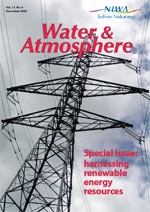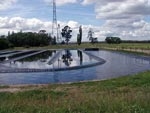PDF of this article (110 KB)



Rupert Craggs heads a team that uses enhanced ponds to recover energy and produce biofuel.
Can the pond systems used for wastewater treatment by New Zealand’s rural communities, farms, and industries be turned into small power stations providing electricity for local use? NIWA research is developing a pond-based wastewater-treatment system that will recover energy from the wastewater solids as biogas and grow single-cell algae as a biofuel using the wastewater nutrients. Enhancing pond treatment for energy recovery will also reduce greenhouse gas emissions (methane and carbon dioxide) and reduce the impact of wastewater discharges on receiving environments.
Energy recovery and capture
The research addresses three questions.
- Can low-cost pond systems provide anaerobic digestion of waste streams and economic capture of biogas for energy?
- Can pond-system algae grown on wastewater nutrients be used to efficiently scrub the carbon dioxide (CO2) and other impurities from biogas (typically 60% methane, 40% CO2) or other waste exhaust or flue gases from industry?
- Can algal biomass be used as a renewable energy source through anaerobic digestion to biogas?
All of these processes occur naturally, to some degree, in conventional wastewater pond systems. NIWA is developing specific pond designs that enhance particular processes and can be adapted to treat any organic wastewaters (such as domestic, dairy farm, and piggery) in New Zealand conditions.
Energy from rural wastewater biomass
Anaerobic digesters are used to recover energy from wastewater biomass at treatment plants in New Zealand’s larger cities, but such technology is not cost-effective in rural areas. Earthen pond-based anaerobic treatment systems are much more affordable and should be able to be incorporated into existing pond infrastructures. Monitoring the efficiency of anaerobic digestion in conventional wastewater treatment ponds is helping to optimise their performance under New Zealand conditions.
Gas scrubbing by algal ponds
When algae grow in wastewater treatment ponds they assimilate carbon (as CO2) and nutrients (ammonia and phosphate). As there are proportionally more nutrients than carbon dioxide available, algal growth becomes limited by lack of carbon. CO2 can be readily absorbed into pond water during the day when algae are growing. Thus pond water can be used to either enhance biogas to enable more efficient combustion or to scrub carbon dioxide and other impurities from industry exhaust or flue gases.
Laboratory experiments have shown that carbon dioxide is easily scrubbed from biogas when bubbled through algal pond water. The efficiency of CO2 scrubbing is enhanced by the nutrients in the wastewater, enabling further algal growth. Research using pilot-scale ponds will determine how CO2 scrubbing influences wastewater treatment performance, and what increase in algal growth can be achieved.
Energy from algal biomass
The algal biomass grown in wastewater treatment ponds can be harvested and anaerobically digested to produce biogas as a renewable energy source. Laboratory experiments are under way to determine the efficiency of biogas production from algal biomass.
Dr Rupert Craggs is a specialist in natural wastewater treatment, based at NIWA in Hamilton.
Teachers’ resource for NCEA AS: Science 90191 (1.6), 90313 (2.2). See other curriculum connections at www.niwa.co.nz/pubs/wa/resources
